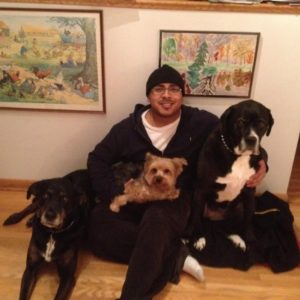 Every year on the High Holidays, police officers sit outside our synagogue to protect our community and building from harm.
Every year on the High Holidays, police officers sit outside our synagogue to protect our community and building from harm.
I understand why the police are there. I know the risk that comes with openly celebrating Judaism. And I appreciate their presence…until all their eyes are on me, a man wearing a kippah (head covering) and a gold Star of David necklace who also happens to be a person of color.
When I arrive, the officers stop, get out of their cars, and follow me into the building. They don’t stop pursuing me until the greeter has given the officers a thumbs-up, signaling I am “safe.”
I have been attending the same synagogue in Minnseota for more than 20 years, and I have never seen this happen to anyone else. I am left to think that the only possible sign of threat is the color of my skin, as 99% of the people who walked into the shul before me are white.
I’ve belonged to Beth Jacob Synagogue in Mendota Heights, MN, since my childhood. I was adopted by a white Jewish couple, and we celebrated Shabbat every week at shul. I attended the St. Paul Talmud Torah Day School from preschool through the eighth grade. Throughout, I proudly celebrated Judaism with my family and friends.
But then, something changed.
After an away game with the 7th grade Talmud Torah soccer team, I experienced the sting of being “different” for the first time.
The two teams had lined up to demonstrate good sportsmanship—each of our hands high-fiving those from the opposing team, followed by the standard, “Good game”— when one of other team’s players called out, “Good game, burnt toast.”
At that moment, I realized that I was not the same as my teammates. I was outraged, ready to fight. But when I looked around, my teammates had already walked away. I felt truly alone, and defeated.
Occasionally, kids from different synagogues and summer camps would ask me, “Are you an Ethiopian Jew?” I didn’t know how to respond. They made it seem as if that was the only way I could be both a person of color and a Jew.
Now that I am grown, those two key pieces of my identity seem to become even more mutually exclusive. No longer do I walk down the street holding on to my mother’s white hand; I am no longer afforded that privilege or protection. I am Jewish, but the world sees me as simply a person of color.
Now, whenever I see police, my blood goes cold, my legs start shaking as if everything below my kneecaps has disappeared, and I get a knot in my stomach the size of a cantaloupe.
And when I walk through the synagogue parking lot on the holiest of days and glimpse police cars through the corner of my eye, my mind races with nervous energy and “What ifs.” What if an officer stops me before I walk into the building? Will they know that I won’t have my wallet on me for immediate identification? What if the police arrest me?
What if there was no one waiting at the front door to greet me and give the officer that thumbs up?
The problem does not lie solely with the police. They have a very difficult and honorable job. I respect what they do. But how can we encourage all officers, and all people, to extend the benefit of the doubt to people of color?
Who is going to lay down the first brick to start building trust?
As Jews, we can begin by challenging our assumptions – by reminding ourselves and our children that not all Jews are white.
I have fear in my blood, but hope in my heart.
Rafael Lev is an entrepreneur and active member of the Twin Cities Jewish community, serving as a coach and mentor for Jewish youth. He also creates awareness for issues related to race, religion, and the intersection of the two, through his work as a public speaker and multimedia producer. He is a member ofBeth Jacob Synagogue in Mendota Heights, MN.

